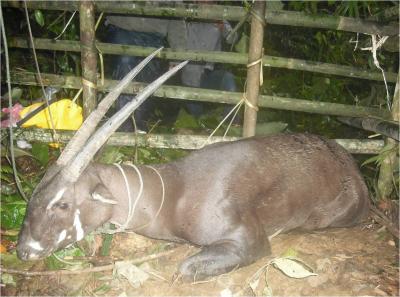This article is more than 1 year old
'Unicorn' captured in remote Laos mountain forests
Incredibly rare species now even rarer
A unfeasibly rare two-horned "unicorn" has been sighted for the first time in ten years in the remote mountain forests of the Far East. Unfortunately the creature was captured by local villagers and died before international unicorn boffins could reach the scene.

The rare animal in question is the saola, a type of two-horned antelope-like creature apparently related to wild cattle. It was first discovered in 1992, and lives only in the dense high forests of the Annamite (Truong Son) Mountains along the Laos/Vietnam border, where once the People's Army of Vietnam* marched along the Ho Chi Minh Trail to war against the Americans.
The saola is so rare that none has ever been seen first-hand in the wild by a biologist, and until last month there had been no confirmed sightings since 1999 - when automatic camera traps snapped pics of the seldom-seen "unicorns". Some researchers have suggested that the saola is behind the ancient Chinese myth of the qilin, a fantastical creature equivalent to the European tradition of the unicorn.
Now it appears that a single adult male saola has once again wandered into contact with humanity, reportedly being discovered last month in a sacred wood outside a village in the remote Xaychamphon District of Bolikhamxay province and brought back by its captors to their village, where it subsequently died.
A statement issued by the Lao People's Democratic Republic Provincial Conservation Unit of Bolikhamxay Province said:
The death of this saola is unfortunate. But at least it confirms an area where it still occurs, and the government will immediately move to strengthen conservation efforts there.
Scientists consider that the wild saola population may be as low as scores, or a few hundred at most. There are none in zoos. The species is classed as "Critically Endangered" by the International Union for the Conservation of Nature (IUCN).
Laotian wildlife officials and scientists apparently set out to Xaychamphon District to release the saola as soon as they heard about its capture, but reached the remote village too late.
"We hope the information gained from the incident can be used to ensure that this is not the last saola anyone has a chance to see," commented IUCN bigwig William Robichaud.
"Study of the carcass can yield some good from this unfortunate incident," added Dr Pierre Comizzoli, Smithsonian Institute veterinarian and member of the IUCN's saola working group. "Our lack of knowledge of saola biology is a major constraint to efforts to conserve it, and this can be a major step forward in understanding this remarkable and mysterious species."
"It's clear that further awareness-raising efforts about the special status of saola are needed," adds Robichaud. "But the saola doesn't have much time left - at best a few hundred survive, but it may be only a few dozen. The situation is critical." ®
*Aka North Vietnamese Army, or NVA, in the parlance of US troops at the time.
